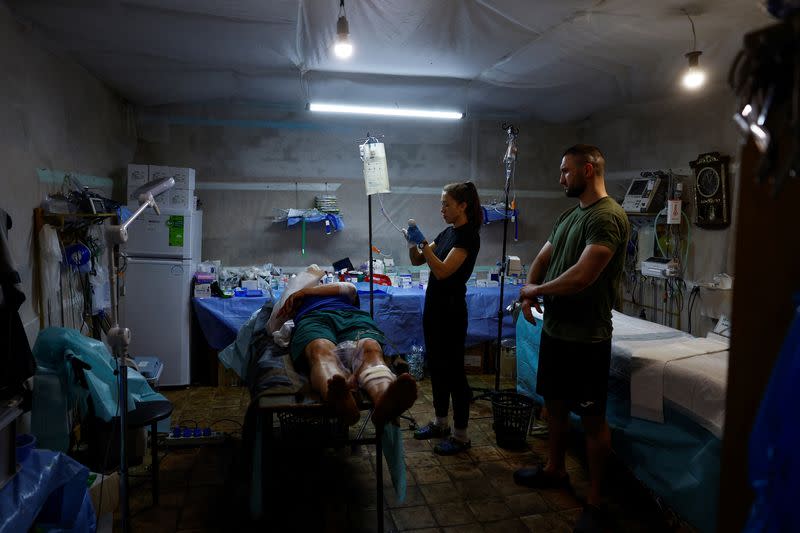At field hospital in Ukraine's battered east, the wounded keep coming

By Anna Voitenko and Alina Smutko
NEAR CHASIV YAR, Ukraine (Reuters) - When the first casualty is wheeled into a brightly lit makeshift field hospital on a stretcher, Ukrainian medic Osmach quickly checks to see if he is conscious.
The wounded soldier confirms that he is, and is transferred to a bed at this medical stabilisation point located close to the eastern Ukrainian town of Chasiv Yar, scene of fierce clashes with advancing Russian forces.
The round-the-clock facility is one of dozens on the 1,000-km (around 600 miles) frontline in the east and south of the country where injured fighters are first brought to stabilise their condition before being sent on to hospitals further from the fighting.
"Those are guys that come here and fuel you with their heroism and positive emotions ... you don't have the right to allow yourself to give up, to hang your head," said Osmach, a 37-year-old anaesthetist who goes only by his military call sign.
As he spoke, he put on blue surgical gloves in preparation for a shift during which he and a small team of medics dealt with a steady stream of casualties suffering from various injuries to limbs, shoulder and head.
The blood-stained boots of a badly injured soldier were placed neatly on the floor as medics rushed to cut away his military fatigues before treating his wounds.
Ukrainian forces have begun to receive billions of dollars worth of Western military aid that has eased acute shortages of ammunition and armour, but Russia's bigger army continues to grind out territorial gains at a high cost on both sides.
"Our capabilities for transporting (the wounded) have changed with the armoured vehicles," Osmach said of recent fresh supplies. "We don't have as many as we'd want, but we have at least some. We now work at day and at night."
Kyiv is in the midst of a fresh mass mobilisation drive to replenish its depleted army, as casualties mount and exhaustion grows.
Sanych, a 48-year-old surgeon who also gave only his call sign, said he was treating soldiers for a wide range of injuries, and he fretted over his ability to operate under intense pressure.
"You worry the most about the fact that your own hands have to continue working," he told Reuters during a recent visit to the field hospital. "And about keeping a clear mind even in critical situations, that's what I'm worried about."
In an ambulance taking a soldier from the stabilisation point to a safer location, 24-year-old Halyna said she had never considered becoming a combat medic when she volunteered to join the armed forces.
"The most difficult part is not being at home and not seeing your family," she said, as the vehicle sped along bumpy roads under cover of night. "But here we are like a family and help out each other."
(Editing by Jon Boyle)


